History
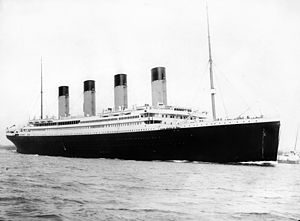 On this, the 105 anniversary of the April 10, 1912 sailing of the RMS Titanic, for her maiden and only voyage, my thoughts have been leaning toward the people who were on board, and particularly those who did not survive that fateful trip. The Titanic was the most amazing ship of it’s time, filled with luxuries beyond the imagination…at least in first class. Back then, people were separated into classes based on their social importance. It’s sad to think about that, because every person has value, and many of those in 3rd class, or steerage were considered expendable. Nevertheless, it was not just those in steerage who lost their lives when Titanic went down on April 12th, 1912.
On this, the 105 anniversary of the April 10, 1912 sailing of the RMS Titanic, for her maiden and only voyage, my thoughts have been leaning toward the people who were on board, and particularly those who did not survive that fateful trip. The Titanic was the most amazing ship of it’s time, filled with luxuries beyond the imagination…at least in first class. Back then, people were separated into classes based on their social importance. It’s sad to think about that, because every person has value, and many of those in 3rd class, or steerage were considered expendable. Nevertheless, it was not just those in steerage who lost their lives when Titanic went down on April 12th, 1912.
As Titanic set sail on April 10th, here was much excitement. Those who were “lucky” enough to have secured passage, were to be envied. Of course, the rich and famous had no trouble paying for their passage, but the less fortunate had a different situation, and different accommodations. Many of the steerage passengers had spent their last penny to pay for their passage, and still they considered it money well spent, because they were heading to America for a better life. Little did any of the passengers in all three classes know that in just two days, their beautiful ship would be at the bottom of the ocean, along with many of her passengers and crew. It is here that I began to wonder what they were thinking as the ship sank beneath their feet, into the deep dark 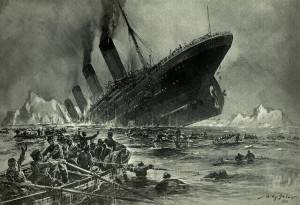 murky depths. I know most of them were just trying to find a way to get onto one of the life boats…of which there were too few by at least half, but did it also become that moment when they thought about what might have been for them…had they not taken this particular trip, on this particular ship. I think that anytime a person finds themselves faced with death, their thoughts turn to family, friends, and what might have been. Most luxury trips taken are for a few reasons…among them the scenery, a long awaited visit, or just the sheer luxury of this particular type of trip. No one really considers what might happen if things go wrong, or at the very least, we try not to think about it. Still, when the moment of emergency arrives, did the passengers of Titanic think that if only they had waited for Titanic’s next trip, they wouldn’t be here today…in this most horrible of situations, with so many others screaming in fear, because they knew they were about to die…unless a miracle happened for them.
murky depths. I know most of them were just trying to find a way to get onto one of the life boats…of which there were too few by at least half, but did it also become that moment when they thought about what might have been for them…had they not taken this particular trip, on this particular ship. I think that anytime a person finds themselves faced with death, their thoughts turn to family, friends, and what might have been. Most luxury trips taken are for a few reasons…among them the scenery, a long awaited visit, or just the sheer luxury of this particular type of trip. No one really considers what might happen if things go wrong, or at the very least, we try not to think about it. Still, when the moment of emergency arrives, did the passengers of Titanic think that if only they had waited for Titanic’s next trip, they wouldn’t be here today…in this most horrible of situations, with so many others screaming in fear, because they knew they were about to die…unless a miracle happened for them.
Titanic was carrying 2,222 people (passengers and crew), when she set sail. Of those people only 706 would receive that miracle. For the rest, this would be the end of their life. Of the 706 survivors, 492 were passengers, and 214 were crew members, a fact that I find rather odd. The class distinctions were closer to expected, with 61% of first class passengers surviving, 42% of second class passengers surviving, and 24% of third class passengers surviving. That is a sad reality of a time when class was everything. I’m sure that all of 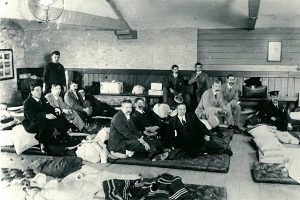 these people felt that their lives were a tremendous gift, and I’m sure too that their lives changed in a big way. Still, I wonder about the final thoughts of the 1516 people who died that day. I’m sure they wished they had not taken the trip, and I’m sure that they regretted the fact that their family would be sad. It really doesn’t matter what they were thinking, I guess, because it was too late to change what was…for most of them anyway. For the holder of Ticket number 242154, it appears that it was not to late. The holder of that ticket is unknown, but they were given a full refund for their ticket, and it appears that they did not sail on Titanic. Perhaps, they had their ear to the Lord’s Word, and were told not to sail. Not knowing who this person was, we will never know for sure.
these people felt that their lives were a tremendous gift, and I’m sure too that their lives changed in a big way. Still, I wonder about the final thoughts of the 1516 people who died that day. I’m sure they wished they had not taken the trip, and I’m sure that they regretted the fact that their family would be sad. It really doesn’t matter what they were thinking, I guess, because it was too late to change what was…for most of them anyway. For the holder of Ticket number 242154, it appears that it was not to late. The holder of that ticket is unknown, but they were given a full refund for their ticket, and it appears that they did not sail on Titanic. Perhaps, they had their ear to the Lord’s Word, and were told not to sail. Not knowing who this person was, we will never know for sure.
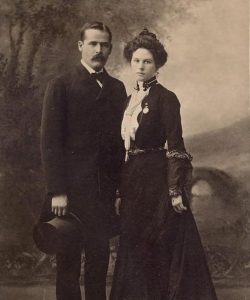 Over the years, many have speculated about the validity of the death of famous people, among them, Elvis Presley. For some unknown reason, people just cant believe, for whatever reason, that someone famous is dead. Butch Cassidy and the Sundance Kid were legendary outlaws who robbed trains, payroll couriers, and banks. When the law got too close to them, they took off for Bolivia. It wasn’t a plan that fared well…or was it? Robert Leroy Parker was born April 13, 1866, in Beaver, Utah. As a bandit, he used the alias Butch Cassidy. Harry Alonzo Longabaugh born in Mont Clare, Pennsylvania in 1867, was better known as Butch Cassidy’s sidekick and partner in crime, the Sundance Kid. The two of them had an illustrious criminal career, but as with all criminal careers, at some point mistakes are made, or they meet their match in a lawman who bests them, with a gun or their abilities as a detective. A part of the Wild Bunch, the careers of Butch Cassidy and the Sundance Kid were shrouded in mystery, but that mystery pales by comparison to their deaths. After making their escape to Argentina, and then to Bolivia, Cassidy, the Kid, and girlfriend, Etta Place thought that the small town of San Vicente would be an easy target for their crimes.
Over the years, many have speculated about the validity of the death of famous people, among them, Elvis Presley. For some unknown reason, people just cant believe, for whatever reason, that someone famous is dead. Butch Cassidy and the Sundance Kid were legendary outlaws who robbed trains, payroll couriers, and banks. When the law got too close to them, they took off for Bolivia. It wasn’t a plan that fared well…or was it? Robert Leroy Parker was born April 13, 1866, in Beaver, Utah. As a bandit, he used the alias Butch Cassidy. Harry Alonzo Longabaugh born in Mont Clare, Pennsylvania in 1867, was better known as Butch Cassidy’s sidekick and partner in crime, the Sundance Kid. The two of them had an illustrious criminal career, but as with all criminal careers, at some point mistakes are made, or they meet their match in a lawman who bests them, with a gun or their abilities as a detective. A part of the Wild Bunch, the careers of Butch Cassidy and the Sundance Kid were shrouded in mystery, but that mystery pales by comparison to their deaths. After making their escape to Argentina, and then to Bolivia, Cassidy, the Kid, and girlfriend, Etta Place thought that the small town of San Vicente would be an easy target for their crimes.
As courier for the Aramayo, Francke and Cia mining company, Carlos Pero was riding his mule up a rugged trail high in the Andes Mountains on the morning of November 4, 1908. He was completely unaware that his every move was being watched. Pero later said that after cresting a hill, he was “surprised by two Yankees, whose faces were covered with bandanas and whose rifles were cocked and ready to fire.” The pair of masked bandits robbed the courier of the company’s payroll and then disappeared into the desolation of southern Bolivia, but that was not to be the end of it. Three days later, four Bolivian officers cornered a pair of Americans suspected of being the bandits in a rented house, in the dusty village of San Vicente. The Pinkerton Detective Agency, which had long been trailing Butch Cassidy and the Sundance Kid, and had warned banks across South America to be on the lookout for them, because they had fled there from the United States in 1901. It was 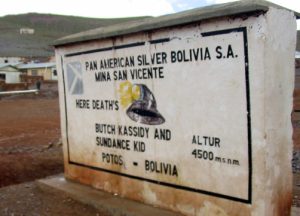 reported that the two Americans holed up in San Vicente were them. As a Bolivian soldier approached the hideout, the Americans shot him dead. A brief exchange of gunfire ensued. When it was over, San Vicente mayor Cleto Bellot reported hearing “three screams of desperation” followed by two gunshots from inside the house. When the Bolivian authorities cautiously entered the hideout the following morning, they found the bodies of the two foreigners.
reported that the two Americans holed up in San Vicente were them. As a Bolivian soldier approached the hideout, the Americans shot him dead. A brief exchange of gunfire ensued. When it was over, San Vicente mayor Cleto Bellot reported hearing “three screams of desperation” followed by two gunshots from inside the house. When the Bolivian authorities cautiously entered the hideout the following morning, they found the bodies of the two foreigners.
For decades, Daniel Buck and Anne Meadows, husband and wife researchers scoured South American archives and police reports trying to track down the true story of what happened to Butch Cassidy and the Sundance Kid, a saga that Meadows detailed in her book “Digging up Butch and Sundance.” While the paper trail pointed to their deaths in Bolivia, conclusive evidence as to the identities of the bandits killed in San Vicente in November 1908 rested under the ground of the village’s cemetery. The researchers enlisted the help of Clyde Snow, the renowned forensic anthropologist who had conclusively identified the remains of Nazi war criminal Josef Mengele. They received permission from Bolivian authorities to exhume the robbers’ bodies. Guided to their purported grave by an elderly villager whose father had reportedly witnessed the shootout, they opened the graves in 1991. Inside they found a skeleton of one man, and a piece of a skull from another. After a detailed forensic analysis and a comparison of DNA to the relatives of Cassidy and Longabaugh, Snow found there was no match. The skeleton was instead likely to have been that of a German miner named Gustav Zimmer who had worked in the area. It’s possible that the bodies of the iconic outlaws remain buried elsewhere in the San Vicente cemetery or even elsewhere in the country, but with no conclusive proof as to the whereabouts of the bodies of Butch Cassidy and the Sundance Kid, their ultimate fate remains a mystery.
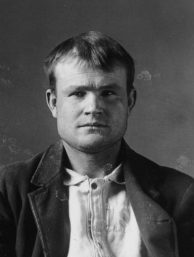
With no conclusive evidence to confirm the deaths of Butch Cassidy and the Sundance Kid, the rumors flew, that the pair had once again eluded the long arm of the law, and sightings of the duo in South America, Mexico and the United States continued for decades to come. Family members fueled the stories by insisting that the men had never been killed and instead returned to the United States to live into old age. Cassidy’s sister, Lula Parker Betenson, wrote in her 1975 book “Butch Cassidy, My Brother” that the outlaw had returned to the family ranch in Circleville, Utah, in 1925 to visit his ailing father and attend a family wedding. According to Betenson, Cassidy told the family that a friend of his had planted the story that one of the men killed in Bolivia was him so that he would no longer be pursued. She claimed that Cassidy lived in the state of Washington under an alias until his death in 1937. Betenson said her brother was buried in an unmarked grave in a location that was kept a family secret.
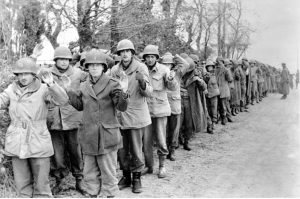 For as long as there have been wars, there have been prisoners of war. Obviously, part of the reason was to take those soldiers out of the fighting. If you are fighting against less enemy combatants, you have a better change of winning. It was a simply a part of war. Both sided took prisoners, and both sides knew that the other side was going to take prisoners. It was not the fact that prisoners were taken, but rather the way they were treated that made this part of war ugly sometimes.
For as long as there have been wars, there have been prisoners of war. Obviously, part of the reason was to take those soldiers out of the fighting. If you are fighting against less enemy combatants, you have a better change of winning. It was a simply a part of war. Both sided took prisoners, and both sides knew that the other side was going to take prisoners. It was not the fact that prisoners were taken, but rather the way they were treated that made this part of war ugly sometimes.
I’m sure that if there was work to do, it made sense to use the prisoners of war 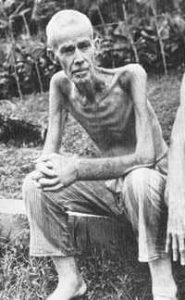 as, basically slave labor…make them earn their keep, so to speak, but often they were beaten, starved, overworked to the point of exhaustion, and basically treated like they were sub-human. Some nations were worse than others. And sometimes, the prisoners of war, weren’t even combatants, but civilians taken hostage for a variety of reasons…most of which had nothing to do with them being a danger in battle. Of course, from about the time of the Vietnam war, it became harder to tell if someone was a “combatant” or not. When children were sent out to interact with soldiers…bombs strapped to their chest…soldiers had to learn to be less than hospitable to the little ones too.
as, basically slave labor…make them earn their keep, so to speak, but often they were beaten, starved, overworked to the point of exhaustion, and basically treated like they were sub-human. Some nations were worse than others. And sometimes, the prisoners of war, weren’t even combatants, but civilians taken hostage for a variety of reasons…most of which had nothing to do with them being a danger in battle. Of course, from about the time of the Vietnam war, it became harder to tell if someone was a “combatant” or not. When children were sent out to interact with soldiers…bombs strapped to their chest…soldiers had to learn to be less than hospitable to the little ones too.
I understand the need for prisoners of war, when the war is still going on, but what is appalling is the treatment of the prisoners sometimes, and the refusal to give the prisoners back at the end of the conflict. Vietnam was also one of the times when prisoners were held long after the war. I know that sometimes the reasons for holding prisoners is that the opposing government refuses to abide by the conditions of the 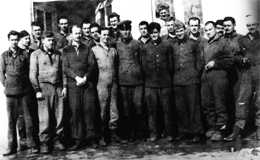 surrender of the losing side. Still, sometimes, the prisoners were held, for no legitimate reason, and for far longer than was reasonable. After World War II, the western Allies released their final prisoners in 1948, but many German POWs in the USSR were held for several more years. Most were used as slave labor in copper or coal mines, and anywhere between 400,000, and up to one million eventually died while in Russian custody. Some 20,000 former soldiers were still in Soviet hands at the time of Joseph Stalin’s death in 1953, and the last 10,000 didn’t get their freedom until 1955 and 1956 a full decade after the war had ended. That seems completely unconscionable to me, but then I’m not part of an evil nation.
surrender of the losing side. Still, sometimes, the prisoners were held, for no legitimate reason, and for far longer than was reasonable. After World War II, the western Allies released their final prisoners in 1948, but many German POWs in the USSR were held for several more years. Most were used as slave labor in copper or coal mines, and anywhere between 400,000, and up to one million eventually died while in Russian custody. Some 20,000 former soldiers were still in Soviet hands at the time of Joseph Stalin’s death in 1953, and the last 10,000 didn’t get their freedom until 1955 and 1956 a full decade after the war had ended. That seems completely unconscionable to me, but then I’m not part of an evil nation.
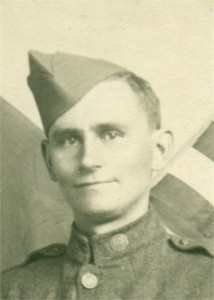 The United States is often called the Sleeping Giant. In the past, the United States has been known as the most powerful country in the world…back in the good old days, that is. Now China, Japan and Russia are also considered to be powerful countries where nuclear weaponry is concerned. The dollar was also the powerful currency, then and even now. The president of the United States was always considered the most powerful person, and I think still is today, or is moving back into that position. All these things considered, the United States was definitely a sleeping giant, because if it woke up it would do everything in its power to rectify things around the globe. As we saw on September 11, 2001, when terrorists attacked our country. Like Toby Keith sang in his song Courtesy Of The Red, White, And Blue (The Angry American), “Justice will be served, and the battle will rage. This big dog will fight when you rattle his cage. And you’ll be sorry that you messed with the U.S. of A” That is notoriously the way the United States has been when it comes to world conflict…slow to anger, but once we are in a war…we are in it to win it!
The United States is often called the Sleeping Giant. In the past, the United States has been known as the most powerful country in the world…back in the good old days, that is. Now China, Japan and Russia are also considered to be powerful countries where nuclear weaponry is concerned. The dollar was also the powerful currency, then and even now. The president of the United States was always considered the most powerful person, and I think still is today, or is moving back into that position. All these things considered, the United States was definitely a sleeping giant, because if it woke up it would do everything in its power to rectify things around the globe. As we saw on September 11, 2001, when terrorists attacked our country. Like Toby Keith sang in his song Courtesy Of The Red, White, And Blue (The Angry American), “Justice will be served, and the battle will rage. This big dog will fight when you rattle his cage. And you’ll be sorry that you messed with the U.S. of A” That is notoriously the way the United States has been when it comes to world conflict…slow to anger, but once we are in a war…we are in it to win it!
The same held true for the other wars we have been in. We might not jump in early, but when we do…look out. On this day, April 6, 1917, the United States Senate voted 82 to 6 to declare war against Germany, the United 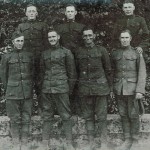 States House of Representatives endorses the declaration by a vote of 373 to 50, and America formally entered World War I. This action would be the one that would send my grandfather, George Byer to war. He was 24 years old. Grandpa didn’t talk much about his time in the war…at least not that I remember. I think that most of the men who came home after fighting in a war, are just happy to be home. They want to put it all behind them, and move forward with their lives, knowing that if it was ever necessary he would go back again. He was a patriot, and that was what patriots did. In fact, when the time came for the men to register for the “old man draft” of World War II…a time when men up to the age of 65 were required to register for the draft, Grandpa was honored to register, as were the other men between the ages of 45 and 65. These men felt like their time of usefulness was over, and when they were told that they were needed again, even if it was just for work on the home front, they all jumped at the chance to serve.
States House of Representatives endorses the declaration by a vote of 373 to 50, and America formally entered World War I. This action would be the one that would send my grandfather, George Byer to war. He was 24 years old. Grandpa didn’t talk much about his time in the war…at least not that I remember. I think that most of the men who came home after fighting in a war, are just happy to be home. They want to put it all behind them, and move forward with their lives, knowing that if it was ever necessary he would go back again. He was a patriot, and that was what patriots did. In fact, when the time came for the men to register for the “old man draft” of World War II…a time when men up to the age of 65 were required to register for the draft, Grandpa was honored to register, as were the other men between the ages of 45 and 65. These men felt like their time of usefulness was over, and when they were told that they were needed again, even if it was just for work on the home front, they all jumped at the chance to serve.
As for World War I, Grandpa would serve, and he would come home. Then, he would go on to live a long life…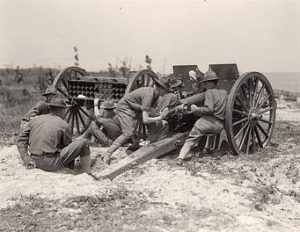 forever changed from the man he once was, because you see, war changes a man. They are changed by what they see, whether they were required to take a life or not. And if they were required to kill, then kill they would, because The Sleeping Giant had been awakened, and the Big Dog’s cage had been rattled. The United States would go to war, and they would win, along with their alleys, because losing was not an option…not if the world was to remain the kind of place we knew and loved. Germany was an evil empire, and that evil empire had to be stopped. I am very proud of my grandfather’s service, and I’m thankful that the Big Dog fought in this one and the other wars it has fought in. It was an important fight, and we needed to win it.
forever changed from the man he once was, because you see, war changes a man. They are changed by what they see, whether they were required to take a life or not. And if they were required to kill, then kill they would, because The Sleeping Giant had been awakened, and the Big Dog’s cage had been rattled. The United States would go to war, and they would win, along with their alleys, because losing was not an option…not if the world was to remain the kind of place we knew and loved. Germany was an evil empire, and that evil empire had to be stopped. I am very proud of my grandfather’s service, and I’m thankful that the Big Dog fought in this one and the other wars it has fought in. It was an important fight, and we needed to win it.
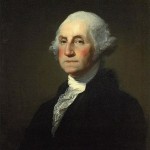 For anyone who has watched the process of getting a bill made law in Congress, the word Veto is a well known word. If the president doesn’t like the bill, he can always threaten to veto it, forcing Congress to get a two-thirds majority vote in both the House of Representatives and in the Senate to override his presidential veto. The exact number depends on how many representatives vote, so the actual number is subject to change. The word veto is Latin for I forbid, and it is the power used to unilaterally stop an official action, especially the enactment of legislation. Therefore, if the president doesn’t like the bill, even if it has passed the House and Senate, he can veto it to see if he can keep it from being passed on a second vote.
For anyone who has watched the process of getting a bill made law in Congress, the word Veto is a well known word. If the president doesn’t like the bill, he can always threaten to veto it, forcing Congress to get a two-thirds majority vote in both the House of Representatives and in the Senate to override his presidential veto. The exact number depends on how many representatives vote, so the actual number is subject to change. The word veto is Latin for I forbid, and it is the power used to unilaterally stop an official action, especially the enactment of legislation. Therefore, if the president doesn’t like the bill, even if it has passed the House and Senate, he can veto it to see if he can keep it from being passed on a second vote.
The first veto ever exercised was by President George Washington on April 5, 1792. The bill introduced a new plan for dividing seats in the House of Representatives that would have increased the amount of seats for northern states. After consulting with his politically divided and contentious cabinet, President Washington, who came from the southern state of Virginia, ultimately decided that the plan was unconstitutional because it provided for additional representatives for some states, and it would have introduced a number of representatives higher than that allowed by the Constitution. After a discussion with 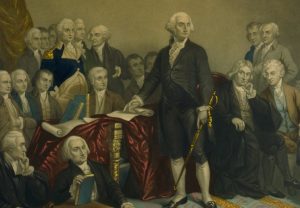 the president, Thomas Jefferson wrote in a letter that votes for or against the bill were divided along perfectly geographical lines between the North and South. Jefferson observed that Washington feared that a veto would incorrectly portray him as biased toward the South. In the end, Jefferson was able to convince the president to veto the bill on the grounds that it was unconstitutional and introduced principles that were liable to be abused in the future. Jefferson suggested apportionment instead be derived from “arithmetical operation, about which no two men can ever possibly differ.” With Washington’s veto, the bill was sent back to Congress. Though representatives could have attempted to overrule the veto with a two-thirds vote, Congress instead threw out the original bill and instituted a new one that apportioned representatives at “the ratio of one for every thirty-three thousand persons in the respective States.” That is a much more fair plan, in my opinion. George Washington would go on to veto one more bill during his time in office. In February 1797, the former commanding general of the Continental Army vetoed an act that would have reduced the number of cavalry units in the army. Neither of the vetoes were overridden by Congress.
the president, Thomas Jefferson wrote in a letter that votes for or against the bill were divided along perfectly geographical lines between the North and South. Jefferson observed that Washington feared that a veto would incorrectly portray him as biased toward the South. In the end, Jefferson was able to convince the president to veto the bill on the grounds that it was unconstitutional and introduced principles that were liable to be abused in the future. Jefferson suggested apportionment instead be derived from “arithmetical operation, about which no two men can ever possibly differ.” With Washington’s veto, the bill was sent back to Congress. Though representatives could have attempted to overrule the veto with a two-thirds vote, Congress instead threw out the original bill and instituted a new one that apportioned representatives at “the ratio of one for every thirty-three thousand persons in the respective States.” That is a much more fair plan, in my opinion. George Washington would go on to veto one more bill during his time in office. In February 1797, the former commanding general of the Continental Army vetoed an act that would have reduced the number of cavalry units in the army. Neither of the vetoes were overridden by Congress.
 Thirty six of the 45 presidents have vetoed at least one bill, with the most regular vetoes going to Franklin D Roosevelt with 372…seconded by Grover Cleveland with 346. There is also something called a pocket veto, which is basically when the president simply does nothing…refusing to sign it into law, or to veto it outright, and it was used by a number of presidents as well. That one seems strange to me, but it seems to have the same procedure to pass the bill into law that the regular veto does. Politics is a messy business, because with so many people involved, there is bound to be differing opinions on what should be done. Nevertheless, try as he might, while the buck might stop at the president’s office, the bill might not, but only if Congress can get its collective act together and vote to override a presidential veto.
Thirty six of the 45 presidents have vetoed at least one bill, with the most regular vetoes going to Franklin D Roosevelt with 372…seconded by Grover Cleveland with 346. There is also something called a pocket veto, which is basically when the president simply does nothing…refusing to sign it into law, or to veto it outright, and it was used by a number of presidents as well. That one seems strange to me, but it seems to have the same procedure to pass the bill into law that the regular veto does. Politics is a messy business, because with so many people involved, there is bound to be differing opinions on what should be done. Nevertheless, try as he might, while the buck might stop at the president’s office, the bill might not, but only if Congress can get its collective act together and vote to override a presidential veto.
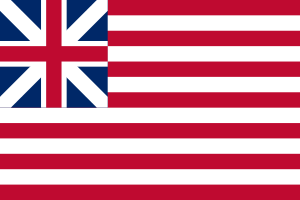 With the American flag at the center of so many protests, it seemed to me a good time to discuss the flag that many, and I believe truly most, Americans hold so dear. Over the years that the United states has been a nation, there have been a number of different flags. As we grew, the flag had to change to show the growing number of states. There were people who were not happy about the move from a flag with 13 stars to one with 20 stars…so the decision was made to reduce the number of stripes to 13, in order to honor the original 13 colonies. On this day, April 4, 1818, Congress passed an act to do just that at the suggestion of United States Naval Captain Samuel C Reid. The plan also allowed for a new star to be added when each new state was admitted. The stripes would never change. The act specified that each new flag design should become official on the first July 4, our Independence Day, following admission of one or more new states. The most recent change, from 49 stars to 50, occurred in 1960 when the present design was chosen, after Hawaii gained statehood in August 1959. Before that, the admission of Alaska in January 1959 prompted the debut of a short-lived 49 star flag. If another state were ever to be added, I think it would take some getting used to. Our current flag has been the flag for 57 years after all. That is almost all of my life.
With the American flag at the center of so many protests, it seemed to me a good time to discuss the flag that many, and I believe truly most, Americans hold so dear. Over the years that the United states has been a nation, there have been a number of different flags. As we grew, the flag had to change to show the growing number of states. There were people who were not happy about the move from a flag with 13 stars to one with 20 stars…so the decision was made to reduce the number of stripes to 13, in order to honor the original 13 colonies. On this day, April 4, 1818, Congress passed an act to do just that at the suggestion of United States Naval Captain Samuel C Reid. The plan also allowed for a new star to be added when each new state was admitted. The stripes would never change. The act specified that each new flag design should become official on the first July 4, our Independence Day, following admission of one or more new states. The most recent change, from 49 stars to 50, occurred in 1960 when the present design was chosen, after Hawaii gained statehood in August 1959. Before that, the admission of Alaska in January 1959 prompted the debut of a short-lived 49 star flag. If another state were ever to be added, I think it would take some getting used to. Our current flag has been the flag for 57 years after all. That is almost all of my life.
For 241 years, the American flag has been the symbol of our nation’s strength and unity. It’s been a source of pride and inspiration for millions of citizens. It has been a prominent icon in our national history. On January 1, 1776, the Continental Army was reorganized in accordance with a Congressional resolution which placed American forces under George Washington’s control. On that New Year’s Day the Continental Army moved to take back Boston, which had been previously been taken over by the British Army. Washington ordered the Grand Union flag hoisted above his base at Prospect Hill. It had 13 alternate red and white stripes and the British Union Jack in the upper left-hand corner. In May of 1776, Betsy Ross sewed the first American flag. On June 14, 1777, in order to establish an official flag for our newly independent nation, the Continental Congress passed the first Flag Act, which read, “Resolved, That the flag of the United States be made of thirteen stripes, alternate red and white; that the union be thirteen stars, white in a blue field, representing a new Constellation.” Congress passed several acts between 1777 and 1960, that changed the shape, design and arrangement of the flag and allowed for additional stars and stripes to be added to reflect the admission of each new state. The Act of January 13, 1794 provided for 15 stripes and 15 stars after May 1795. The Act of April 4, 1818 provided for 13 stripes and one star for each state, to be added to the flag on the 4th of July following the admission of each new state, signed by President Monroe. An Executive Order by President Taft dated June 24, 1912, established proportions of the flag and provided for arrangement of the stars in six horizontal rows of eight each, a single point of each star to be upward. The Executive Order of President Eisenhower dated January 3, 1959, provided for the arrangement of the stars in seven rows of seven stars each, staggered horizontally and vertically. The Executive Order of President Eisenhower dated August 21, 1959, provided for the arrangement of the stars in nine rows of stars staggered horizontally and eleven rows of stars staggered vertically. Today the flag consists of thirteen horizontal stripes, seven red alternating with 6 white. The stripes represent the original 13 colonies, the stars represent the 50 states of the Union. Even the colors of the flag are symbolic…Red symbolizes Hardiness and Valor, White symbolizes Purity and Innocence, and Blue represents Vigilance, Perseverance and Justice.
Our flag is more than just a piece of cloth, or a protesting tool. It is a flag to be proud of, not to burn. It is the symbol of a great nation…a nation that rushes to the defense of other weaker nations, so that they can remain free…a nation that vehemently protects the rights of it’s citizens, even when every fiber of its being want to slap 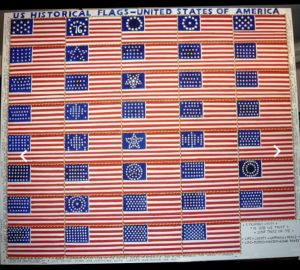 some people silly. Our nation knows that if one right is taken away, it opens a door for others to be lost as well. Our freedom depends on our insistence to follow the rules laid out before us…like them or not. As a patriot, I understand that, but I also wish that those who use the freedom to protest, would also realize that in burning the flag, they are, in essence, saying that they don’t think that we should have the very freedoms they use to protest. It is really a vicious circle when you think about it. They are fighting, and burning a flag, in an effort to have the freedom to do what they want, but in doing so, they are saying that they don’t respect the nation that made that very thing possible for them. What a strange idea!
some people silly. Our nation knows that if one right is taken away, it opens a door for others to be lost as well. Our freedom depends on our insistence to follow the rules laid out before us…like them or not. As a patriot, I understand that, but I also wish that those who use the freedom to protest, would also realize that in burning the flag, they are, in essence, saying that they don’t think that we should have the very freedoms they use to protest. It is really a vicious circle when you think about it. They are fighting, and burning a flag, in an effort to have the freedom to do what they want, but in doing so, they are saying that they don’t respect the nation that made that very thing possible for them. What a strange idea!
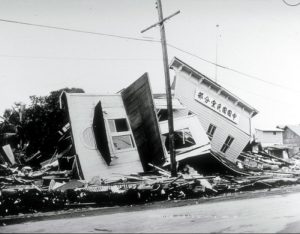
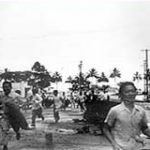 When most of us think about April Fool’s Day, we think of playing some funny prank on our family or friends, but on April Fool’s Day 1946, the Earth played a prank, if it could be called that, on Hawaii. It was a prank that wasn’t funny, and it would claim the lives of 159 people. Early in the morning of that April Fool’s Day, a 7.4 magnitude earthquake struck in the North Pacific, 13,000 feet beneath the ocean surface, and off Unimak Island in the Aleutian chain, that makes up the tail of Alaska. The quake triggered devastating tidal waves throughout the Pacific, and particularly aimed at Hawaii. The first tidal wave hit Unimak Island shortly after the quake struck. The wave was estimated to be almost 100 feet, and it crashed into a lighthouse 30 feet above sea level. Five people lived in the lighthouse. It was smashed to pieces, and all five were killed instantly. The wave then headed toward the Southern Pacific at 500 miles per hour. The situation was like a freight train carrying an atomic bomb.
When most of us think about April Fool’s Day, we think of playing some funny prank on our family or friends, but on April Fool’s Day 1946, the Earth played a prank, if it could be called that, on Hawaii. It was a prank that wasn’t funny, and it would claim the lives of 159 people. Early in the morning of that April Fool’s Day, a 7.4 magnitude earthquake struck in the North Pacific, 13,000 feet beneath the ocean surface, and off Unimak Island in the Aleutian chain, that makes up the tail of Alaska. The quake triggered devastating tidal waves throughout the Pacific, and particularly aimed at Hawaii. The first tidal wave hit Unimak Island shortly after the quake struck. The wave was estimated to be almost 100 feet, and it crashed into a lighthouse 30 feet above sea level. Five people lived in the lighthouse. It was smashed to pieces, and all five were killed instantly. The wave then headed toward the Southern Pacific at 500 miles per hour. The situation was like a freight train carrying an atomic bomb.
Hawaii was 2,400 miles south of the quake’s epicenter, and Captain Wickland of the United States Navy was the first person to spot the coming wave at about 7:00am, four and a half hours after the quake struck in the Aleutian Islands. His position on the bridge of a ship, 46 feet above sea level, put him at eye level with a “monster wave” that he described as two miles long. The first wave came in and receded, then the water in Hilo Bay seemed to disappear. The boats that were docked there, settled on the sea floor, surrounded by flopping fish. Then…the second wave hit…and it was massive!! The city of Hilo was hit by a 32 foot wave that devastated the town. Nearly a third of the city was completely destroyed. The bridge that crossed the Wailuku River was picked up by the wave, and pushed 300 feet away. In Hilo, 96 people lost their lives in the tsunami. Other parts of Hawaii were hit even worse. In some places, the waves reached heights of 60 feet. A schoolhouse in Laupahoehoe was crushed by the tsunami, killing the teacher and 25 students inside.
The massive wave was seen as far away as Chile, where, 18 hours after the quake near Alaska, unusually large waves crashed ashore, but there were no casualties. This tsunami prompted the United States to establish the Seismic SeaWave Warning System two years later, which is now known as the Pacific Tsunami Warning System. 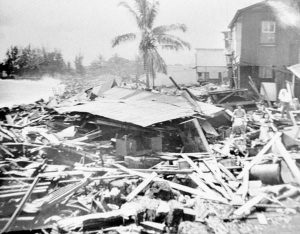
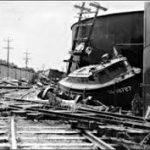 It uses undersea buoys throughout the ocean, in combination with seismic-activity detectors, to find possible killer waves. The warning system was used for the first time on November 4, 1952. That day, an evacuation was successfully carried out, but the expected wave never materialized. Still, like the fire drills we all know about from school, maybe Tsunami Drills wouldn’t be a bad thing either, especially if it would prevent the kind of loss of life that Hawaii experienced on that awful April Fool’s Day in 1946.
It uses undersea buoys throughout the ocean, in combination with seismic-activity detectors, to find possible killer waves. The warning system was used for the first time on November 4, 1952. That day, an evacuation was successfully carried out, but the expected wave never materialized. Still, like the fire drills we all know about from school, maybe Tsunami Drills wouldn’t be a bad thing either, especially if it would prevent the kind of loss of life that Hawaii experienced on that awful April Fool’s Day in 1946.
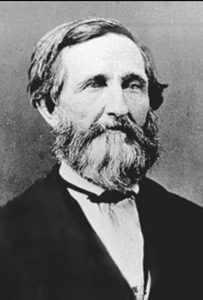 In the movies about the old west, you often see a gun fight. If someone got shot, the procedure to get the bullet out, was…well, painful. When we think of an operation, we think of a person being under anesthesia, and completely asleep during the entire procedure. In reality, prior to March 30, 1842, people who had to have an operation, had better have a strong constitution, because the best a doctor could do for them was to have them bite down on a stick. Now, this didn’t reduce the pain, but I suppose it lessened the noise level of the scream that the doctor knew was coming. I’m sure that surgery was seriously the last resort, and even often delayed longer than it should have been, simply because of the pain involved.
In the movies about the old west, you often see a gun fight. If someone got shot, the procedure to get the bullet out, was…well, painful. When we think of an operation, we think of a person being under anesthesia, and completely asleep during the entire procedure. In reality, prior to March 30, 1842, people who had to have an operation, had better have a strong constitution, because the best a doctor could do for them was to have them bite down on a stick. Now, this didn’t reduce the pain, but I suppose it lessened the noise level of the scream that the doctor knew was coming. I’m sure that surgery was seriously the last resort, and even often delayed longer than it should have been, simply because of the pain involved.
Enter, Dr Crawford Williamson Long, an American surgeon and pharmacist. Long was a bright child, graduating from the local academy at 14 years old, and continuing on to the University of Georgia in Athens. In 1835, he received his Masters Degree. Then, he began studying at Transylvania College in the fall of 1836 in Lexington, Kentucky. Long studied under Benjamin Dudley, a revered surgeon. He observed and participated in many surgeries and noted the effects of operating without anesthesia. Long transferred to the University of Pennsylvania in Philadelphia after spending only a year at Transylvania College, and was introduced to some of the most cutting edge medical technology of the time. He received his MD degree at the University of Pennsylvania in 1839.
After an 18 month internship in New York, Dr Long returned to Georgia. He took over a rural medical practice in Jefferson, Georgia in 1841. After observing the same physiological effects with Diethyl Ether that Humphry Davy had described for nitrous oxide in 1800, he used Ether for the first time on March 30, 1842 to remove a tumor from the neck of a patient, James M. Venable. He administered Sulfuric Ether on a towel and simply had the patient inhale. He performed many other surgeries using this technique over the next few years. Then, he introduced the technique to his obstetrics practice as well. Long subsequently removed a second tumor from Venable and used Ether as an anesthetic in amputations and childbirth. While Long’s use of Ether continued for quite a while, he didn’t immediately publish his findings. The results of these trials were eventually published in 1849 in The Southern Medical and Surgical Journal. It was a major advancement in surgical procedures.
 General anesthesia suppresses central nervous system activity and results in unconsciousness and total lack of sensation. Sedation suppresses the central nervous system to a lesser degree, inhibiting both anxiety and creation of long-term memories without resulting in unconsciousness. Of course, Ether is no longer used, because of the dangerous side effects, but many other types of anesthesia have been developed since Ether was used. I can’t imagine just how awful it would be to have surgery without anesthesia, and I for one am glad that it was developed. My shoulder surgery would have been horrible, if it had to be done without my arm being completely numb with a newer form of medicine that kept it numb, and me comfortable all that day.
General anesthesia suppresses central nervous system activity and results in unconsciousness and total lack of sensation. Sedation suppresses the central nervous system to a lesser degree, inhibiting both anxiety and creation of long-term memories without resulting in unconsciousness. Of course, Ether is no longer used, because of the dangerous side effects, but many other types of anesthesia have been developed since Ether was used. I can’t imagine just how awful it would be to have surgery without anesthesia, and I for one am glad that it was developed. My shoulder surgery would have been horrible, if it had to be done without my arm being completely numb with a newer form of medicine that kept it numb, and me comfortable all that day.
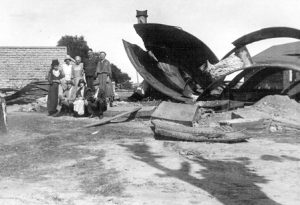
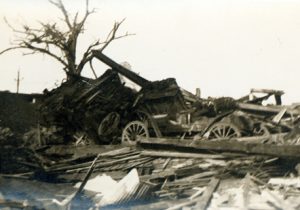 Over the centuries, tornadoes have managed to wreak havoc on various areas of the world, not to mention the thousands of lives they have taken. With advancements in the early warning systems and on weather conditions, the deaths have decreased, but in 1920, no such systems existed. It was March 28, 1920…Palm Sunday, when at least 37 tornadoes, 31 of which were significant, raged across the Midwest and Deep South states. The tornadoes left more than 380 dead, as well as at least 1,215 injured. Many communities and outlying farmers alike were caught off guard as the storms moved to the northeast at speeds that reached over 60 miles per hour. Georgia saw most of the fatalities with over 200 deaths. Indiana had 56 deaths and Ohio had 55, while the other states saw fewer fatalities. Without ways to monitor the tornadoes, very little is known about many of the specific tornadoes that occurred.
Over the centuries, tornadoes have managed to wreak havoc on various areas of the world, not to mention the thousands of lives they have taken. With advancements in the early warning systems and on weather conditions, the deaths have decreased, but in 1920, no such systems existed. It was March 28, 1920…Palm Sunday, when at least 37 tornadoes, 31 of which were significant, raged across the Midwest and Deep South states. The tornadoes left more than 380 dead, as well as at least 1,215 injured. Many communities and outlying farmers alike were caught off guard as the storms moved to the northeast at speeds that reached over 60 miles per hour. Georgia saw most of the fatalities with over 200 deaths. Indiana had 56 deaths and Ohio had 55, while the other states saw fewer fatalities. Without ways to monitor the tornadoes, very little is known about many of the specific tornadoes that occurred.
Early in the morning of March 28th, severe thunderstorms began developing in Missouri, moving quickly to the northeast towards Chicago, Illinois. The first tornado injured five people 35 miles southeast of Springfield, Missouri, in Douglas County. This first tornado was a warning of things to come as the morning went on and the atmosphere began to destabilize, due to the abundance of sunshine that preceded the cold front in the warm sector, which covered the lower Great Lakes region extending southward, well past the Ohio River Valley. According to meteorologist and weather historian Charles Merlin Umpenhour, the climatic conditions on Palm Sunday 1920 were favorable for all the atmospheric ingredients to come together that were needed to create the classic setup for long-track tornadoes. The forecasting…or communications technology and public awareness about Severe Weather was nearly nonexistent in 1920. That technology would not begin for another 33 years, when the US Weather Bureau implemented its Public Watch.
The residents of the Great Lakes region and Ohio Valley areas, had as their only source of weather information, the rather vague forecasts that were issued in the local newspaper the day before or by word of mouth. The use of the word “tornado” was strictly prohibited in public weather forecasting until the 1950s because of the fear and panic it might cause. This policy would come under fire in the years to come especially after the Tri-State Tornado in 1925 that stands today as the deadliest tornado in American history…as it should have. It would be insane not to let the people know of such deadly weather, simply because someone might get scared. That really is the point of it. To “scare” people into action!! It saves lives.
Weather forecasters and the public alike in the Chicago, Dayton, Fort Wayne, Lansing, South Bend, and Toledo areas were unaware of the likelihood of a significant tornado outbreak that would follow a beautiful Palm Sunday afternoon. The weather maps in use in March 1920 showed a rather large and deep cyclone over northern Iowa, and they knew it would be moving across central Lower Michigan by nightfall with a cold front right behind it. Meteorologists knew rain showers, and very likely thundershowers, were a good possibility, but were unaware that the helicity (which is a property of a moving fluid which represents the potential for helical flow…or a flow which follows the pattern of a corkscrew to evolve. Helicity is proportional to the strength of the 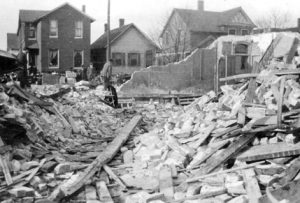
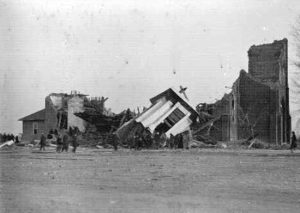 flow, the amount of vertical wind shear, and the amount of turning in the flow known as a vorticity), the lifted index, and upper level winds which were being guided by a strong jet stream with a probable negative tilt. When all that is put together, it creates conditions that are favorable for the development of tornadoes, and thereby, a seriously dangerous situation. Had the people known all that in 1920, perhaps most of the lives lost, could have been saved.
flow, the amount of vertical wind shear, and the amount of turning in the flow known as a vorticity), the lifted index, and upper level winds which were being guided by a strong jet stream with a probable negative tilt. When all that is put together, it creates conditions that are favorable for the development of tornadoes, and thereby, a seriously dangerous situation. Had the people known all that in 1920, perhaps most of the lives lost, could have been saved.
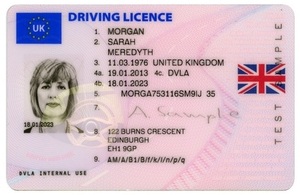 Most people in the United States consider driving a car a right, but in reality it is a privilege, and must be earned. At 15 a child may obtain a permit to drive with a licensed driver by taking a written exam. Then in a year, or at age 16, they have to take a written and driving test to get a license. The driving test can be waived if they have completed driver’s education. The exams are pretty basic, and in this country, most people pass the test on the first try, and if not on the first try, most pass on the second try. The first driving test was administered in 1899 Chicago and New York City. Massachusetts and Missouri were the first US states to require a license for driving a motor vehicle in 1903. Pennsylvania’s 1909 licensing laws were the first to give an age restriction “18 years of age” and the first state to allow 16 year olds to drive, if they were accompanied by a licensed driver, was Connecticut in 1921. I’m sure that prior to these times most people didn’t have one of the new fangled automobiles, so a license was not needed.
Most people in the United States consider driving a car a right, but in reality it is a privilege, and must be earned. At 15 a child may obtain a permit to drive with a licensed driver by taking a written exam. Then in a year, or at age 16, they have to take a written and driving test to get a license. The driving test can be waived if they have completed driver’s education. The exams are pretty basic, and in this country, most people pass the test on the first try, and if not on the first try, most pass on the second try. The first driving test was administered in 1899 Chicago and New York City. Massachusetts and Missouri were the first US states to require a license for driving a motor vehicle in 1903. Pennsylvania’s 1909 licensing laws were the first to give an age restriction “18 years of age” and the first state to allow 16 year olds to drive, if they were accompanied by a licensed driver, was Connecticut in 1921. I’m sure that prior to these times most people didn’t have one of the new fangled automobiles, so a license was not needed.
The United Kingdom made the move to require testing on March 24, 1934, and the requirements were a little different than in the United States. The test must be taken in order to receive a full license, and also to add full entitlements to an existing license. The test varies, depending on the class of vehicle that is to be driven, and is administered by the Driver and Vehicle Standards Agency or DVSA, in Great Britain and the Driver and Vehicle Agency, or DVA in Ireland. Those parts of the program seem to be just like here in the United States, but from there on out, there is a pretty big difference. In the United Kingdom, the minimum age at which one can take a driving test is currently 16 for mopeds and 17 for cars, with an exception allowed at 16 for those on the higher/enhanced rate of the mobility component. In addition to a driving licence, a CBT certificate may be required before a moped or motorcycle is ridden.
In Great Britain around 1.6 million people take the practical car test per year. Approximately 43% of those who take it pass the test, and the theory test has a pass rate of about 51.6%. Now I don’t know what you think, but I think the kids in this country would be pretty upset if only half of those who took the test got to actually drive  legally. Then again, maybe kids would study harder for the test in that case. I can’t tell you how many times I have heard a kid say, “It’s all common sense.” My thought is, “What wealth of knowledge about driving a car is a 15 year old, who has never driven one, going to have.” The answer is obvious…to the parents anyway. If they don’t study, they will likely not pass, but what of the people of Great Britain and Ireland. They know the test is difficult. My guess is that they do study, but that the test is a much more advanced version than those in the United States. Maybe it’s because they want it to be more than just common sense. I’m not saying our tests are too easy…but it’s something to consider when you look at the statistics.
legally. Then again, maybe kids would study harder for the test in that case. I can’t tell you how many times I have heard a kid say, “It’s all common sense.” My thought is, “What wealth of knowledge about driving a car is a 15 year old, who has never driven one, going to have.” The answer is obvious…to the parents anyway. If they don’t study, they will likely not pass, but what of the people of Great Britain and Ireland. They know the test is difficult. My guess is that they do study, but that the test is a much more advanced version than those in the United States. Maybe it’s because they want it to be more than just common sense. I’m not saying our tests are too easy…but it’s something to consider when you look at the statistics.

